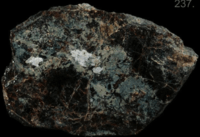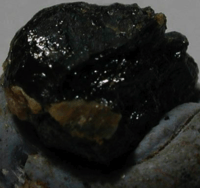Minerals/Transuranics
< Minerals
Minerals containing transuranics are not rare. But, the stability of such isotopes makes it unlikely to find large concentrations of specific elements.
The transuranics start after uranium (U) in the periodic table. They include the named elements: plutonium (Pu), americium (Am), curium (Cm), berkelium (Bk), californium (Cf), einsteinium (Es), fermium (Fm), mendelevium (Md), nobelium (No), lawrencium (Lr), rutherfordium (Rf), dubnium (Db), seaborgium (Sg), bohrium (Bh), hassium (Hs), meitnerium (Mt), darmstadtium (Ds), roentgenium (Rg), copernicium (Cn), flerovium (Fl), and livermorium (Lv).
Neptuniums
The image at the top of the page shows a rock with the mineral Aeschynite approximately centered above the biotite mica. Aeschynite "probably contains on the order of a few atoms of neptunium at any one time, as part of the complex decay chain of the uranium that makes up a much larger fraction of the sample."[1]
Plutoniums

"The sample [on the right] representing plutonium is the naturally occurring mineral muromontite, which is a mixture of uranium and beryllium. [The] alpha particles from the decay of uranium are captured by the beryllium atoms, which in turn release neutrons. [...] In the case of this sample, [...] the neutrons are in turn re-captured by the uranium, which then undergoes further decay and is transformed into plutonium. The result is that this mineral contains the highest known naturally occurring concentration of plutonium."[2]
Americiums
Sorption of americium at trace levels has been detected on a clay mineral.[3]
Curiums
"Curium is a radioactive transuranic element that has only been produced in nuclear reactors. It is possible that some curium and other transuranic elements were created in the natural nuclear reactor in Oklo, Gabon."[4]
Berkeliums
Like americium and curium it "is possible that some berkelium and other transuranic elements were created in the natural nuclear reactor in Oklo, Gabon."[5]
Roentgeniums
"Based on the observation of the long-lived isotopes of roentgenium, 261Rg and 265Rg (Z = 111, t1/2 ≥ 108 y) in natural Au, an experiment was performed to enrich Rg in 99.999% Au. 16 mg of Au were heated in vacuum for two weeks at a temperature of 1127°C (63°C above the melting point of Au). The content of 197Au and 261Rg in the residue was studied with high resolution inductively coupled plasma-sector field mass spectrometry (ICP-SFMS). The residue of Au was 3 × 10−6 of its original quantity. The recovery of Rg was a few percent. The abundance of Rg compared to Au in the enriched solution was about 2 × 10−6, which is a three to four orders of magnitude enrichment."[6]
Research
Hypothesis:
- Other longer-lived isotopes of transuranics may be discovered or manufactured.
Control groups

The findings demonstrate a statistically systematic change from the status quo or the control group.
“In the design of experiments, treatments [or special properties or characteristics] are applied to [or observed in] experimental units in the treatment group(s).[7] In comparative experiments, members of the complementary group, the control group, receive either no treatment or a standard treatment.[8]"[9]
Proof of concept
Def. a “short and/or incomplete realization of a certain method or idea to demonstrate its feasibility"[10] is called a proof of concept.
Def. evidence that demonstrates that a concept is possible is called proof of concept.
The proof-of-concept structure consists of
- background,
- procedures,
- findings, and
- interpretation.[11]
See also
References
- ↑ Theodore Gray (20 September 2005). "An example of the element Neptunium". Periodic Table.com. Retrieved 2015-11-05.
- ↑ Theodore W. Gray (19 October 2002). "Natural plutonium-containing mineral". Periodic Table.com. Retrieved 2015-11-05.
- ↑ D. Stammose and J.-M. Dolo (1990). "Sorption of americium at trace levels on a clay mineral". Radiochimica Acta 51: 189-93. https://books.google.com/books?id=AP3wCAAAQBAJ&pg=PA202&lpg=PA202&source=bl&ots=HSbrCjCBzW&sig=TCbSmutAUaFoz9bY4OEShSLPcSw&hl=en&sa=X&ved=0CDsQ6AEwBWoVChMIz8GJ9P_6yAIVRuYmCh24kA0R#v=onepage&f=false. Retrieved 2015-11-05.
- ↑ jolyon (6 November 2015). "The Mineralogy of Curium". Hudson Institute of Mineralogy. Retrieved 2015-11-05.
- ↑ jolyon (6 November 2015). "The Mineralogy of Curium". Hudson Institute of Mineralogy. Retrieved 2015-11-05.
- ↑ A. Marinov, A. Pape, D. Kolb, L. Halicz, I. Segal, N. Tepliakov and R. Brandt (2011). "Enrichment of the Superheavy Element Roentgenium (Rg) in Natural Au". International Journal of Modern Physics E 20 (11): 2391-2401. doi:10.1142/S0218301311020393. http://www.phys.huji.ac.il/~marinov/publications/Rg_261_arXiv_77.pdf. Retrieved 2014-04-08.
- ↑ Klaus Hinkelmann, Oscar Kempthorne (2008). Design and Analysis of Experiments, Volume I: Introduction to Experimental Design (2nd ed.). Wiley. ISBN 978-0-471-72756-9. http://books.google.com/?id=T3wWj2kVYZgC&printsec=frontcover.
- ↑ R. A. Bailey (2008). Design of comparative experiments. Cambridge University Press. ISBN 978-0-521-68357-9. http://www.cambridge.org/uk/catalogue/catalogue.asp?isbn=9780521683579.
- ↑ "Treatment and control groups, In: Wikipedia". San Francisco, California: Wikimedia Foundation, Inc. May 18, 2012. Retrieved 2012-05-31.
- ↑ "proof of concept, In: Wiktionary". San Francisco, California: Wikimedia Foundation, Inc. November 10, 2012. Retrieved 2013-01-13.
- ↑ Ginger Lehrman and Ian B Hogue, Sarah Palmer, Cheryl Jennings, Celsa A Spina, Ann Wiegand, Alan L Landay, Robert W Coombs, Douglas D Richman, John W Mellors, John M Coffin, Ronald J Bosch, David M Margolis (August 13, 2005). "Depletion of latent HIV-1 infection in vivo: a proof-of-concept study". Lancet 366 (9485): 549-55. doi:10.1016/S0140-6736(05)67098-5. http://www.ncbi.nlm.nih.gov/pmc/articles/PMC1894952/. Retrieved 2012-05-09.
External links
![]() This is a research project at http://en.wikiversity.org
This is a research project at http://en.wikiversity.org
| |
Development status: this resource is experimental in nature. |
| |
Educational level: this is a research resource. |
| |
Resource type: this resource is an article. |
| |
Resource type: this resource contains a lecture or lecture notes. |
| |
Subject classification: this is a Geology resource. |